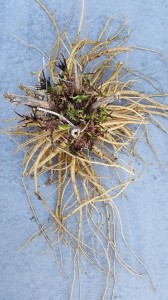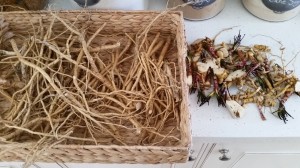Althea officinalis
The marshmallow plant has some amazing medicinal qualities! This plant does all the same things as slippery elm, except it’s not endangered and it grows here in the west… like a weed! It is known as a demulcent herb that contains high levels of mucilage which is a slimy, soothing substance that calms down irritated tissues when used externally or internally. All of it’s family members including, common mallow (the smaller “cheesy” plant), hollyhocks and globe mallow have the same medicinal qualities as marshmallow. The root, leaves and flowers are the medicine. Although the root is the strongest part.
Mucilage plants are soothing to all tissues including the skin, respiratory, digestive and urinary systems. It can be used to clam the GI tract, irritated bronchi and even sooth kidney and bladder discomfort from stones and infections. Interestingly, I just learned that any of the mallow family plants will stop the progression of gangrene or dying tissue, although the tissue can’t be dead yet. It can also be used as a porridge to eat for those who may be malnourished and cannot keep anything else down. This happy plant will grow as a perennial and reseed itself giving you lots of marshmallow baby plants. If you don’t want all those plants just pluck them up and use it all. I like to dry the plants and save them in glass jars for later.
The root in the picture above came from a two year old plant. The best time to harvest roots are in the fall (end of the first year for biennials) or early spring before the plant produces foliage. The reason being is that all the energy or medicine is still in the roots and not sending it up into the plant yet.
It is best to power spray all the soil off the roots and then chop up coarsely, dry completely and store in a glass jar. Just before using, place the herb in a blender and break it up a bit. This will help release more medicine when you go to use it.
You can use the herb in an infusion (tea), tincture or salve or poultice. Any plant that contains mucilage is best prepared as a cold infusion instead of hot. This is very simple to do. Just soak the herb in room temp water over night and then use it the next day. If you don’t have time then go ahead and prepare it the quick way by boiling water first, then allow to cool slightly. Pour over the herbs and let steep for 15 – 20 minutes, then use.
For a salve, try infusing the root in olive oil with comfrey and calendula either in a double broiler over very low heat for an hour or in a glass jar placed in a brown paper bag outside in the warm sun as a solar infusion. Mix 1 oz beeswax with every cup of oil and pour into jars.
If you are taking a high dose of any demulcent plant be sure to take it separate from other herbs, as it can bind with them and not allow proper absorption. It can be taken in other formulas or with other herbs if used in smaller amounts. There are no contraindications.



